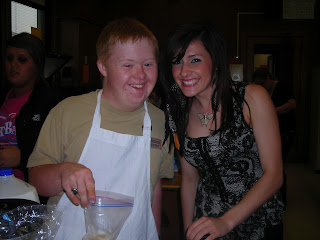Lea deBoer and McKinley Sheehy taste results....
Last week Mrs. Block’s Advanced Chemistry/Chemistry Club
students joined Mrs. Pittenger’s Nutrition and Culinary Arts I Classes for a
tasty chemical reaction treat.
Kevin Nguyen and Kalen Pennington use duct tape to seal their baggies.Duct tape has many uses.
This
crossover lab related the unit of thermochemistry to the making of homemade ice
cream using ice and rock salt to freeze the ice cream ingredients. A chemistry student was paired with a foods student to complete the lab experience.
Cameron Gray (who lost his nose) and Madison Gates measure the sugar and vanilla for their ice cream.
Ice has to absorb energy
(an endothermic reaction) in order to melt, changing the phase of water from a
solid to a liquid.
Steven Baty and Bryar Rardin make learning fun!
When you use ice to cool the ingredients for ice cream, the
energy is absorbed from the ingredients and from the outside environment.
John Marrs and Aubrie Lamb make ice cream.
When
you add salt to the ice, it lowers the freezing point of the ice, so even more
energy has to be absorbed from the environment in order for the ice to melt.
This makes the ice colder than it was before, which is how your ice cream
freezes.
Francesca Rios and Adrienne Haupt feel the heat energy moving out of the ingredients.
Students learned about the many health benefits of ice cream in the
diet. For example, it contains the bone strengthening mineral calcium.
McKinley Sheehy, Alicia Robertson, Haley Johnson, and Karissa Gobin measure out the ingredients.
It also provides vitamin D, vitamin A, and
protein. So remember, ice cream can be
part of a healthful diet as long as it is eaten in moderation.
Lea deBoer and Brie Tyler get ice for the reaction.
Mrs. Block and Mrs. Pittenger.....
















.jpg)
































